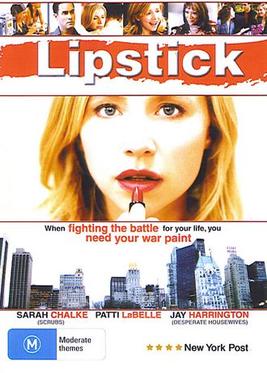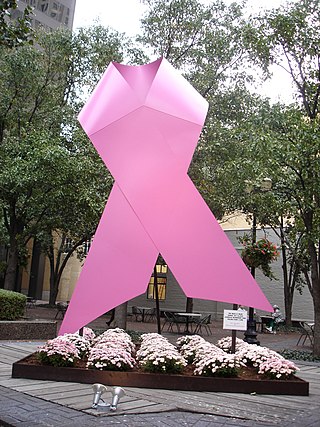Related Research Articles

Breast cancer is a cancer that develops from breast tissue. Signs of breast cancer may include a lump in the breast, a change in breast shape, dimpling of the skin, milk rejection, fluid coming from the nipple, a newly inverted nipple, or a red or scaly patch of skin. In those with distant spread of the disease, there may be bone pain, swollen lymph nodes, shortness of breath, or yellow skin.

Mammography is the process of using low-energy X-rays to examine the human breast for diagnosis and screening. The goal of mammography is the early detection of breast cancer, typically through detection of characteristic masses or microcalcifications.

Mammaplasty refers to a group of surgical procedures, the goal of which is to reshape or otherwise modify the appearance of the breast. There are two main types of mammoplasty:
- Augmentation mammaplasty is commonly performed to increase the size, change the shape, and/or alter the texture of the breasts. This usually involves the surgical implantation of breast implant devices.
- Reduction mammaplasty is commonly performed to reduce the size, change the shape, and/or alter the texture of the breasts. This involves the removal of breast tissue.
Breast pain is the symptom of discomfort in either one or both breasts. Pain in both breasts is often described as breast tenderness, is usually associated with the menstrual period and is not serious. Pain that involves only one part of a breast is more concerning, particularly if a hard mass or nipple discharge is also present.

Barbara Seaman was an American author, feminist activist, and journalist, and a principal founder of the women's health movement.
The National Women's Health Network (NWHN) is a non-profit women's health advocacy organization located in Washington, D.C. It was founded in 1975 by Barbara Seaman, Alice Wolfson, Belita Cowan, Mary Howell, and Phyllis Chesler. The stated mission of the organization is to give women a greater voice within the healthcare system. The NWHN researches and lobbies federal agencies on such issues as AIDS, reproductive rights, breast cancer, older women's health, and new contraceptive technologies. The Women's Health Voice, the NWHN's health information program, provides independent research on a variety of women's health topics.

Ductal carcinoma in situ (DCIS), also known as intraductal carcinoma, is a pre-cancerous or non-invasive cancerous lesion of the breast. DCIS is classified as Stage 0. It rarely produces symptoms or a breast lump one can feel, typically being detected through screening mammography. It has been diagnosed in a significant percentage of men.

Why I Wore Lipstick to My Mastectomy is a 2006 television film that aired on Lifetime Television and starred Sarah Chalke. It is based on the memoir of the same name, written by Geralyn Lucas. The book and the TV movie depict Geralyn Lucas's fight with breast cancer.

Judy Eason McIntyre is an American politician from the U.S. state of Oklahoma. A Democrat, McIntyre served as an Oklahoma state Senator from 2004 to 2012 representing District 11, which includes Osage and Tulsa counties. She also served as State Representative from 2002 to 2004 representing District 73 where she was the first freshman appointed to the Speaker's Leadership Team. For the 16 years before her election to the Oklahoma Legislature, she was an elected board member for the Tulsa Public Schools in Tulsa, Oklahoma.
Dame Valerie Beral AC DBE FRS FRCOG FMedSci was an Australian-born British epidemiologist, academic and a preeminent specialist in breast cancer epidemiology. She was Professor of Epidemiology, a Fellow of Green Templeton College, Oxford and was the Head of the Cancer Epidemiology Unit at the University of Oxford and Cancer Research UK from 1989.
Rose Rehert Kushner was an American journalist and pioneering advocate for breast cancer patients. She wrote the 1975 book Why Me? What Every Woman Should Know About Breast Cancer to Save Her Life.

A BRCA mutation is a mutation in either of the BRCA1 and BRCA2 genes, which are tumour suppressor genes. Hundreds of different types of mutations in these genes have been identified, some of which have been determined to be harmful, while others have no proven impact. Harmful mutations in these genes may produce a hereditary breast–ovarian cancer syndrome in affected persons. Only 5–10% of breast cancer cases in women are attributed to BRCA1 and BRCA2 mutations, but the impact on women with the gene mutation is more profound. Women with harmful mutations in either BRCA1 or BRCA2 have a risk of breast cancer that is about five times the normal risk, and a risk of ovarian cancer that is about ten to thirty times normal. The risk of breast and ovarian cancer is higher for women with a high-risk BRCA1 mutation than with a BRCA2 mutation. Having a high-risk mutation does not guarantee that the woman will develop any type of cancer, or imply that any cancer that appears was actually caused by the mutation, rather than some other factor.

Allyn Rose is an American beauty pageant titleholder, professional speaker, and breast cancer advocate from Newburg, Maryland.

Breast cancer awareness is an effort to raise awareness and reduce the stigma of breast cancer through education about screening, symptoms, and treatment. Supporters hope that greater knowledge will lead to earlier detection of breast cancer, which is associated with higher long-term survival rates, and that money raised for breast cancer will produce a reliable, permanent cure.

Babette Rosmond was an American author.

Deena Metzger is an American writer, healer, and teacher whose work spans multiple genres including the novel, poetry, non-fiction, and plays. Metzger is a creative writing teacher and feminist scholar. In the 1960s and 1970s Metzger was a member of the Critical Studies faculty at the California Institute of the Arts, taught English at Los Angeles Valley College, and was on the faculty of the Feminist Studio Worship. Metzger also founded the writing program at Woman's Building in Los Angeles. Metzger was a contributing editor to Chrysalis: A Magazine of Women's Culture that ran from 1977 to 1980 in Woman's Building.
Sybil Shainwald is an American attorney specializing in women's health law and an activist for women's health reform. She has represented thousands of women and their children in individual and class action suits against manufacturers of harmful drugs, devices, and procedures. Shainwald is former chair of the National Women's Health Network, co-founder of Health Action International and Trial Lawyers for Public Justice.
The women's health movementin the United States refers to the aspect of the American feminist movement that works to improve all aspects of women's health and healthcare. It began during the second wave of feminism as a sub-movement of the women's liberation movement. WHM activism involves increasing women's knowledge and control of their own bodies on a variety of subjects, such as fertility control and home remedies, as well as challenging traditional doctor-patient relationships, the medicalization of childbirth, misogyny in the health care system, and ensuring drug safety.
Natalie Sue Miller was an American fashion model, breast cancer survivor, breast cancer activist, counselor, and author. Born in Kansas City, Missouri, she moved to Denver, Colorado at age 19 as a newlywed and started a career in fashion modeling. After being diagnosed with breast cancer at the age of 34 and undergoing a mastectomy, she created a fashion show featuring models who had also had breast cancer. In 1981, she founded the Sue Miller Day of Caring, a non-profit organization for breast cancer education and awareness. In its first 35 years, the Day of Caring has been a resource for over 17,500 survivors of breast cancer, providing educational forums and support services at its annual event, held in nine U.S. cities. Miller earned her bachelor's and master's degrees at age 60 and 75, respectively, and wrote her autobiography, I'm Tougher Than I Look, in 2004. In 2002, Miller was inducted into the Colorado Women's Hall of Fame.

Nancy Cappello was an American breast cancer activist who was known for her campaign to improve disclosure on the limitations of mammography and the difficulty in identifying cancer for those with dense breast tissue. She worked as a special education teacher in her hometown of Waterbury, Connecticut, and later as an educational administrator in the Connecticut state department.
References
- 1 2 3 4 GEORGIA D. (Aug 25, 1980). "For Family's Three Generations of Feminists, a Memorable Day". New York Times. p. 1 – via ProQuest.
- 1 2 3 4 Saxon, Wolfgang (11 Jan 1995). "Sylvia B. Seaman, 94, a Writer and Suffragist". New York Times.
- 1 2 3 "Sharing StoriesInspiring Change" Jewish Women's Archive.
- ↑ Walton, Edith H. (Sep 19, 1943). "Promiscuous Teacher". New York Times. p. 1 – via ProQuest.
- ↑ Seaman, Sylvia (1955). Glorious to View. Kroch Library Rare & Manuscripts (Non-Circulating). p. 366.
{{cite book}}: CS1 maint: location missing publisher (link) - ↑ Davall, Irene, host. "Voices of Restless Women." Irene Davall Papers, 1971–1987, performance by Sylvia S. Seaman, season 1, episode 8, 1974–1976.
- ↑ Natalie Shainess. Women and the Crisis in Sex Hormones. JAMA. 1978;239(20):2179. doi:10.1001/jama.1978.03280470091039